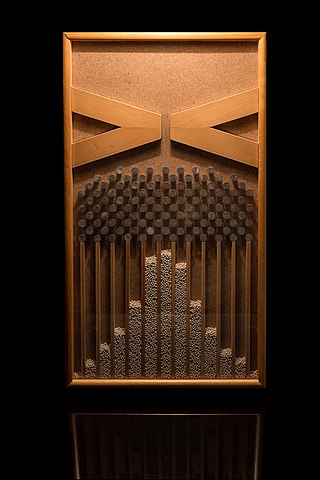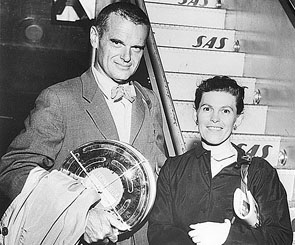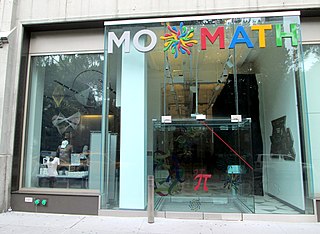
The Galton board, also known as the Galton box or quincunx or bean machine, is a device invented by Francis Galton to demonstrate the central limit theorem, in particular that with sufficient sample size the binomial distribution approximates a normal distribution.

Pacific Science Center is an independent, nonprofit science center in Seattle with a mission to ignite curiosity and fuel a passion for discovery, experimentation, and critical thinking. Pacific Science Center serves more than 1 million people each year at its campus adjacent to Seattle Center, at the Mercer Slough Environmental Education Center in Bellevue, Washington, and in communities and classrooms across the state of Washington.

The Museum of Science (MoS) is a nature and science museum and indoor zoological establishment located in Science Park, a plot of land in Boston and Cambridge, Massachusetts, spanning the Charles River. Along with over 700 interactive exhibits, the museum features a number of live and interactive presentations throughout the building each day, along with scheduled film showings at the Charles Hayden Planetarium and the Mugar Omni Theater.

The California Science Center is a state agency and science museum located in Exposition Park, Los Angeles, next to the Natural History Museum of Los Angeles County and the University of Southern California. The museum includes many exhibits of aircraft and spacecraft, including Space Shuttle Endeavor, multiple hands-on galleries, special exhibitions, and IMAX movies.

The Fleet Science Center is a science museum and planetarium in Balboa Park in San Diego, California. Established in 1973, it was the first science museum to combine interactive science exhibits with a planetarium and an IMAX Dome (OMNIMAX) theater, setting the standard that most major science museums follow today. It is located at the east end of the El Prado Drive walkway, next to the Bea Evenson Fountain and plaza in central Balboa Park.

The Computer Museum was a Boston, Massachusetts, museum that opened in 1979 and operated in three locations until 1999. It was once referred to as TCM and is sometimes called the Boston Computer Museum. When the museum closed and its space became part of Boston Children's Museum next door in 2000, much of its collection was sent to the Computer History Museum in California.
William P. Parker is an American artist, scientist, and entrepreneur, best known for inventing the modern design of the plasma globe. The invention occurred in 1971, when Parker was working as a student in a physics laboratory at the Massachusetts Institute of Technology and accidentally filled a test chamber to a greater-than-usual pressure with ionized neon and argon. Three years later, Parker was artist-in-residence at the Exploratorium in San Francisco and created two installations using this technology, entitled Quiet Lightning and AM Lightning.

The MIT Museum, founded in 1971, is part of the Massachusetts Institute of Technology in Cambridge, Massachusetts. It hosts collections of holography, technology-related artworks, artificial intelligence, architecture, robotics, maritime history, and the history of MIT. Its holography collection of 1800 pieces is the largest in the world, though only a few selections from it are usually exhibited. As of 2023, works by the kinetic artist Arthur Ganson were the largest long-running displays; in 2024 they were replaced by a newer art installation, but some of Ganson's works were reinstalled elsewhere in the museum. There is a regular program of temporary special exhibitions, often on the intersections of art and technology.

Alexander Girard, affectionately known as Sandro, was an architect, interior designer, furniture designer, industrial designer, and a textile designer.

Ray-Bernice Alexandra Kaiser Eames was an American artist and designer who worked in a variety of media.

Charles Eames and Ray Eames were an American married couple of industrial designers who made significant historical contributions to the development of modern architecture and furniture through the work of the Eames Office. They also worked in the fields of industrial and graphic design, fine art, and film. Charles was the public face of the Eames Office, but Ray and Charles worked together as creative partners and employed a diverse creative staff. Among their most recognized designs is the Eames Lounge Chair and the Eames Dining Chair.
Diana Thater is an American artist, curator, writer, and educator. She has been a pioneering creator of film, video, and installation art since the early 1990s. She lives and works in Los Angeles, California.
Raymond Moos Redheffer was an American mathematician. He was the creator of one of the first electronic games, Nim, a knowledge game.

The Exploratorium is a museum of science, technology, and arts in San Francisco, California. Founded by physicist and educator Frank Oppenheimer in 1969, the museum was originally located in the Palace of Fine Arts and was relocated in 2013 to Piers 15 and 17 on San Francisco's waterfront.

Ideum is a company based in Corrales, New Mexico, United States that produces multitouch tables and walls, custom interactive exhibits, and custom hardware. The company was founded in 1999 by Jim Spadaccini, who created interactive exhibits for San Francisco's Exploratorium before becoming creative director at Ideum. With strong ties to the museum and informal science education fields, many of the company's products and services are targeted at museums and other public spaces. In 2015 and 2016, the company was listed on the Inc. 5000, list of the Fastest Growing Companies in the US. In 2017 and again in 2018, the company was honored as one of the "Best Entrepreneurial Companies in America" by Entrepreneur Magazine.

IMAGINARY is an open platform dedicated to the communication of modern mathematics. With over 100 different exhibits, software, films, texts, and images for free use and editing, IMAGINARY connects users from over 50 countries. Science museums such as the German Museum in Munich or the Museum of Mathematics (MoMath) in New York have some of the exhibits in their collections. IMAGINARY also acted as an independent organizer of exhibitions.

The National Museum of Mathematics or MoMath is a mathematics museum in Manhattan, New York City. It opened on December 15, 2012, with over thirty interactive exhibits. The mission of the museum is to "enhance public understanding and perception of mathematics". The museum is known for a special tricycle with square wheels, which operates smoothly on a catenary surface.

The AMNH Exhibitions Lab or AMNH Department of Exhibition is an interdisciplinary art and research team at the American Museum of Natural History that designs and produces museum installations, computer programs and film. Founded in 1869, the lab has since produced thousands of installations, many of which have become celebrated works. The department is notable for its integration of new scientific research into immersive art and multimedia presentations. In addition to the famous dioramas at its home museum and the Rose Center for Earth and Space, the lab has also produced international exhibitions and software such as the revolutionary Digital Universe Atlas.

The Garden of Archimedes is a museum for mathematics in Florence, Italy, founded in 2004. It has been compared to the National Museum of Mathematics in New York City, the only museum in North America devoted to mathematics.

Mathemalchemy is a traveling art installation dedicated to a celebration of the intersection of art and mathematics. It is a collaborative work led by Duke University mathematician Ingrid Daubechies and fiber artist Dominique Ehrmann. The cross-disciplinary team of 24 people, who collectively built the installation during the calendar years 2020 and 2021, includes artists, mathematicians, and craftspeople who employed a wide variety of materials to illustrate, amuse, and educate the public on the wonders, mystery, and beauty of mathematics. Including the core team of 24, about 70 people contributed in some way to the realization of Mathemalchemy.





















